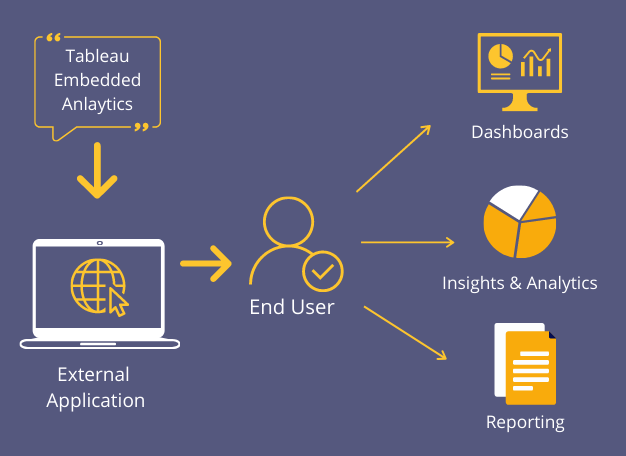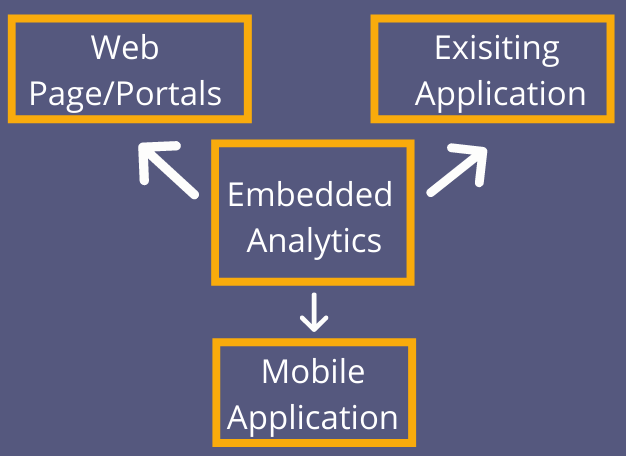What is Embedded Analytics?
Many industries are shifting focus into digital transformation to help them make data-driven decisions and thereby leading to change in strategies to improve their business. As customers are becoming more and more demanding thanks to the rapid increase in technology, driving companies to stay up to date themselves and modifying strategies to suit customers’ demands and adapt their businesses accordingly.
The integration of analytic content and capabilities within business process or external facing applications (like CRM, ERP, Finance, HR, Marketing) is known as embedded analytics.
It provides users with useful data and analytical resources which brings better understanding about the organizations in order to make better decisions and work effectively by integrating the data into external facing applications that they use on a day-to-day basis to provide analytics using visual dashboards. It helps you with evidence to support decision making on a real-time basis in your business context.
How is Embedded Analytics different?
It is best suited for assisting administrative decisions that necessitate highly aggregated views of data from across a department, function, or the entire organization. These systems are designed to work within the framework of an individual whose only responsibility is to conduct data analysis.
Embedded analytics, on the other hand, is a collection of capabilities that are closely incorporated into existing systems (such as your CRM, ERP, marketing automation, or financial systems) that offers you additional awareness, meaning, or predictive capacity to help decision-making for very specific tasks.
It is considered as modern analytics because of embedding analytics into our applications or webpages and providing analytics product to our end users such as customers, partners, vendors, distributors etc.

Now, that you have a glimpse into Embedded Analytics, let’s deep dive into Embedded Analytics (EA) from Tableau. As we all know, Tableau is a powerful BI tool which helps in transforming data into wonderful insights which helps senior management to make better business decisions.
Before starting, few facts regarding EA from Tableau:
- Embedded Analytics is a plug-in model of Tableau
- Tableau’s Engine collate directly into your web application
- It is not a Tableau Desktop
Then, what does Tableau Embedding mean:
“The seamless integration of Tableau Server into another application”
Which means that it can take a number of forms very smoothly. For better understanding, let’s consider a scenario – Let’s take the present case of COVID-19, you are visiting a website to get the information about the number of cases, the number of patients recovered, or a number of deaths based on geography.
And you will see Pie charts, Line Graphs, Data, and many other visualizations on this data and presenting you with real-time (live) data. This is Analytics embedded in another application.
Using embedded Tableau with any webpage or portal – with the help of HTML embed code and Java script APIs – we can provide visual analytics to our customers and more importantly customization to the end users’ interface.
We can embed visual analytics to the existing applications such as Salesforce, SharePoint etc and is not just limited to the former, but also allows integration with mobile applications too whether new or existing application and helps provide seamless visualizations to the end users.

I hope, you now have a clear understanding on what is Embedded Analytics.
Now let’s see, who is using Tableau Embedded Analytics?
Organizations are using Tableau Embedded Analytics – across all industries and departments – to make a more informed decision. Given below are the top 10 industries that lead the adoption of Embedded Analytics.
- Financial Services
- Information Technology
- Manufacturing
- Healthcare
- Business Services
- Retail
- Construction
- Media & Entertainment
- Education
- Consumer Goods
Why Tableau Embedded Analytics and how is it useful in enhancing your business:
- Increasing Return on Investment on Data Transformation – Presenting insights in a user workflow accelerates the value of the data transformation effort. According to the reports the business user adoption rate of traditional BI is 21%, while for embedded analytics it is 60%. The same study emphasizes that 84% of the business users spend more time on applications that feature embedded analytics.
- Increasing Productivity – Embedded analytics enables user to spend less time switching back on application and analytics tools thereby providing more time for value-added activities. Embedded self-service analytics provides end customers with faster access to the information they need while allowing development teams to concentrate on new products that will help the company expand and innovate to differentiate itself.
- Increase in Revenue – Embedded analytics can help organization win more sales, retain customers and expand their product offerings. Embedded analytics provide various new revenue opportunities through data casting and help increase win rate, by decreasing churn rate as well as enhanced feature monetization.
- Improve Customer Loyalty & Satisfaction – As Customer is the king of the Market hence satisfying the customer should be of utmost priority for any organization. Embedding analytics behind customer-facing storefronts or applications can lead to repeat purchases, bigger shopping carts, and more contented consumers as it provides complete clarity, and integrates your existing applications and provides enterprise-grade level security.

Leave a Comments
You must be logged in to post a comment.